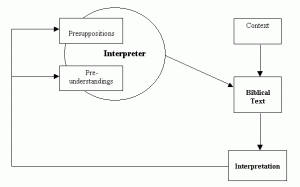 I haven’t put up a post in a while for several reasons. One, I had a hard drive crash which has diverted a lot of time to rebuilding that system. Two, I am busy in the final semester of my Master of Arts degree in Theological Studies. To that end, I am taking a class in hermeneutics. You might ask herm-a-what? So, I thought I would share some of what I am learning. Hermeneutics is broadly defined as the art and science of bridging linguistic, historical, social, and cultural divides between ancient and modern contexts so that one may understand what the ancient texts mean.[1] The term can also be used in the narrower sense of seeking the contemporary application of ancient texts.[2] The first step of interpretation is exegesis. Exegesis is the systematic effort to determine what the original author intended. Paul realized this about the Old Testament:
I haven’t put up a post in a while for several reasons. One, I had a hard drive crash which has diverted a lot of time to rebuilding that system. Two, I am busy in the final semester of my Master of Arts degree in Theological Studies. To that end, I am taking a class in hermeneutics. You might ask herm-a-what? So, I thought I would share some of what I am learning. Hermeneutics is broadly defined as the art and science of bridging linguistic, historical, social, and cultural divides between ancient and modern contexts so that one may understand what the ancient texts mean.[1] The term can also be used in the narrower sense of seeking the contemporary application of ancient texts.[2] The first step of interpretation is exegesis. Exegesis is the systematic effort to determine what the original author intended. Paul realized this about the Old Testament:
For whatever was written in former days was written for our instruction, that through endurance and through the encouragement of the Scriptures we might have hope.(Ro 15:4)
In many ways, we are just like Paul looking back on the Hebrew Bible. While the Bible was written for us, it was not written specifically to us. It was written to its designated audience. The first task of the interpreter is to hear the message of the Bible as the first readers would have understood it. In any text, there are three basic expressions of meaning: 1) what the writer means; 2) what the recipient understands; 3) what meaning is actually encoded in the text.[3] While determining the former two is a historical process, a sound interpretation must account for all three elements. Paramount in the process is a grasp of the historical context of the writing. Within that historical paradigm the occasion and purpose of the writing are centrally important.
God chose specific individuals, like Paul or John, and inspired them to communicate his word for us. For instance, the Apocalypse was written to the seven churches. The Gospels were likely addressed to the specific contexts of each evangelist author. The objective meaning of a passage is the meaning the original inspired author intended. While this may prove elusive, the goal of exegesis is an objective assessment of what the author was communicating to the original recipients. It follows necessarily that his meaning could be understood in the original context and was not based on our perspective of advanced historical developments.[4] Through historical research one can learn much about the author’s environment, occasion and purpose. Commentaries, bible dictionaries, study bibles and other reference works provide a great deal of background material. An essential goal in hermeneutics is to assess the inspired author’s intent. Yet, we as modern readers are far removed from the author’s world. To correctly interpret scripture entails examining our own beliefs as well. Interpretation is broken into four steps in my textbook:
Step 1: Grasp the text in their town. What did the text mean to the original audience?
Step 2: Measure the width of the river to cross. What are the differences between the biblical audience and us?
Step 3: Cross the principlizing bridge. What is the theological principle in this text?
Step 4: Grasp the text in our town. How should individual Christians today apply the theological principle in their lives? [5]
The terms “presuppositions” and “preunderstandings” are actually distinct phenomena. Preunderstanding entails our preconceived  ideas (conscious and unconscious) that we bring to the text prior to engaging in serious study.[6] Preunderstanding involves past teaching and ideas we have gathered about a text that make us assume we already grasp it. These ideas are subject to change as new information is discovered. Presuppositions are different in that they are more fundamental and not related to specific passages rather the whole Bible.[7] An evangelical believer’s presuppositions include the existence of God, angels, demons and the supernatural realm whereas an agnostic may presume that miracles and the supernatural are not actually real. These divergent presuppositions will result in drastically different interpretations of the biblical text.
ideas (conscious and unconscious) that we bring to the text prior to engaging in serious study.[6] Preunderstanding involves past teaching and ideas we have gathered about a text that make us assume we already grasp it. These ideas are subject to change as new information is discovered. Presuppositions are different in that they are more fundamental and not related to specific passages rather the whole Bible.[7] An evangelical believer’s presuppositions include the existence of God, angels, demons and the supernatural realm whereas an agnostic may presume that miracles and the supernatural are not actually real. These divergent presuppositions will result in drastically different interpretations of the biblical text.
Preunderstandings originate generally from one’s culture, family and life experience and more specifically from Sunday school lessons, sermons, books and our own ideas from reading the Bible. They are not always bad but they should be subject to scrutiny. Preunderstandings can be tested by examining them in light of true serious study of the text. Once one has set preconceived ideas aside and undertaken the four step exegetical interpretative process, one can evaluate old ideas and formulate a better informed view. In this way, preunderstandings are dynamic. One should always be willing to modify preunderstandings as new data is discovered.
I know firsthand that one’s spiritual and intellectual history influence interpretation. I was not always a Christian. I became a believer later in life so many of my presuppositions have changed dramatically. Today, I can honestly say I affirm all four of the presuppositions listed on page 95 in the text by Duvall:
1. The Bible is the Word of God. Although God worked through people to produce it, it is nonetheless inspired by the Holy Spirit and is God’s Word to us.
2. The Bible is trustworthy and true.
3. God has entered into human history; thus the supernatural (miracles, etc.) does occur.
4 The Bible is not contradictory; it is unified, yet diverse. Nevertheless, God is bigger than we are, and he is not always easy to comprehend. Thus the Bible also has tension and mystery to it.[8]
However, that was not always so. For instance, I used to be some sort of namby pamby confused deist/new ager. Accordingly, I was proud to boast that I was spiritual but not religious (whatever that means). This is embarrassing but at one point I thought you could just open up the Bible to any page and read and God would providentially point out a message unique to my situation. It was sort of like using the Bible as an Ouija board. Not recommended… Similarly, I also believed in Darwinian evolution. Of course, that colored my view of the first chapters of Genesis. Today, I hold the authority of scripture above the infallibility of science. I simply lack belief in Darwinism. Accordingly, I understand those texts much differently than I used to. This shows that presuppositions can change as well. When I became a Christian a lot of my old ideas were discarded. I have been pursuing serious training in biblical studies to be as accurately informed as I can be concerning God’s word. As my knowledge base increases, my understanding of the Bible evolves.
Complete objectivity is not really possible but it is not really the goal. We are striving to comprehend the message that God inspired the authors to write. As readers we respond based on our preunderstandings and presuppositions. Yet, we continually renew our minds by subjecting it to God’s word (Rom 12:2). When dealing with any written text the authorial intent and reader response are contiguous but not necessarily congruent. In other words, the author’s writing is indeed connected to the reader response but that response is not necessarily the desired result. The meaning of a text can be described as the reader’s response or in terms of the author’s intention. The author has a message in which he encodes in language. The reader assimilates the words and ascribes their personal understanding and association with those words. Because the two do not necessarily share the same definitions and associations, communication can break down. For any non-trivial piece of writing, I maintain that the correct view of meaning must be assigned to authorial intent. The text after all originates in the mind of its author. While the author is responsible for communicating clearly and precisely, it is the reader that chooses how seriously they will seek the author’s intent. A reader’s presuppositions and preferences may cloud effective communication. Readers must make decisions as to how they will interpret a given text. If the reader is honestly seeking to discern the communicated message they must choose to read through the proper contextual lens. In the case of Biblical interpretation this is magnified by translation not to mention considerable cultural and chronological distance. What might have been obvious to a first century reader may take considerable contextual research for a modern reader. To be an effective reader one must be willing to challenge their own presuppositions and thoroughly examine language, context and culture.
[1]William W. Klein, Craig Blomberg, Robert L. Hubbard and Kermit Allen Ecklebarger, Introduction to Biblical Interpretation (Dallas, Tex.: Word Pub., 1993), 5.
[2]Gordon D. Fee and Douglas K. Stuart, How to Read the Bible for All Its Worth, 3rd ed. (Grand Rapids, MI: Zondervan Publishing House, 1993), 29.
[3] Klein, Introduction, 8.
[4] Ibid, 11.
[5]J. Scott Duvall and J. Daniel Hays, Grasping God’s Word: A Hands-on Approach to Reading, Interpreting, and Applying the Bible (Grand Rapids, MI: Zondervan, 2005), 25.
[6]Ibid, 93.
[7]Ibid, 94
[8]Ibid, 95.



